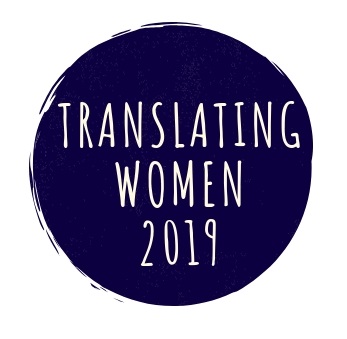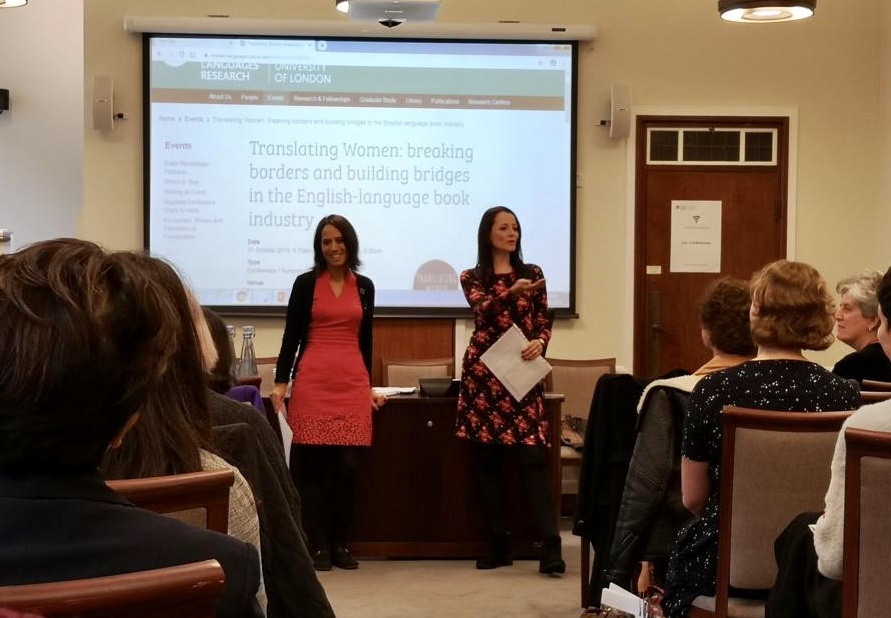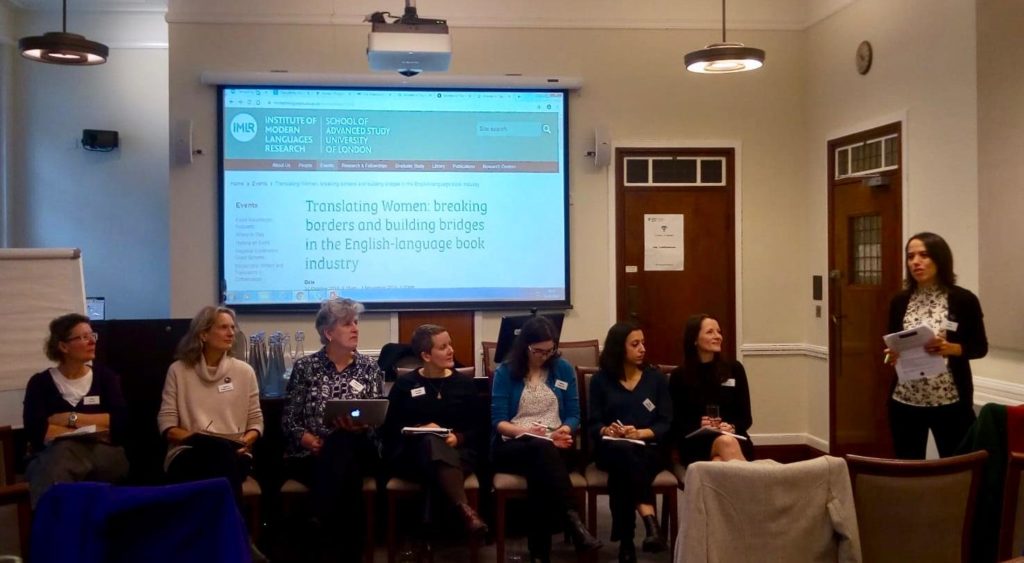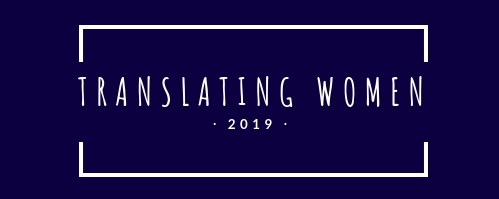
Barbara Spicer reports on the ‘Translating women’ conference held at the IMLR on 31 October – 1 November 2019
Translating Women 2019 was more than just a conference. Literary translator Tina Kover, speaking at the two-day event at the IMLR, captured the warmth, conversations and hospitality beautifully: it felt like a ‘family reunion’. Indeed, the event reunited people who already knew each other virtually; translators, activists, authors, academics, publishers, students at undergraduate and postgraduate levels. The aim of the organisers, Helen Vassallo (University of Exeter) and Olga Castro (University of Warwick) was to promote synergies between academic and publishing contexts. My own reasons for attending were both personal, as a reader and feminist, and academic, as a postgraduate research student investigating the translation process through a feminist lens.

In her inspiring keynote on the first day, Margaret Carson (City University New York) outlined key events in the timeline of the Women in Translation (WIT) movement, including her co-creation with Alta L. Price of the WIT Tumblr in 2015. Although there are still more men being translated, published and reviewed, according to Carson ‘the gender gap and other exclusions in translation are now part of the conversation’. In a digital age, this conversation is increasingly happening online. (Carson’s ‘Notes from the “Translating Women” conference’ are available on the WIT Tumblr.) One of the awareness-raising initiatives highlighted in the keynote was Meytal Radzinski’s Bibliobio blog and Twitter presence. Radzinski, who self-defined as ‘just a reader’ during a plenary session on the second day of conference, inaugurated the WIT month in August 2014 having realised the gender imbalance in her own reading.
In the panel session that followed on the visibility of women in translation, freelance literary translator Rosalind Harvey stated that it is necessary to look critically not only at who is being translated but how they are being marketed. This point was taken up by Aysun Kiran who examined the ways Turkish female-authored books are being presented in English translation through their paratexts. Kiran gave an example of a reductive review which features on the cover of Ece Temelkuran’s Women Who Blow on Knots: ‘A beach-read with brains and bounce’. It is hard to imagine the same type of description being applied to a book by a man. The gendered notion of the ‘Great Writer’ in literary translation may linger on, but as Carson asserted, ‘it’s becoming harder and harder to defend in light of #WIT activism’.
In the panel on translation as activism, Chicago-based writer and translator Aviya Kushner introduced the concept of ‘expectation bias’, or what society expects from women writers. Kushner noted the inherent bias in telling any woman what she should write about, and how this affects how and where translations are published and received. This bias, she argued passionately, erases their individuality and narrows ‘the full complexity of women’s lives’ to their domestic sphere. I was particularly moved by Kushner’s readings of two female poets she had translated. One, 92 year old Riwa Soffer, does not conform to societal expectations in her writing. Her poetry deals with lust, sex and ageing. And why not? A wealth of literature is still not getting into readers’ hands, and the editors-as-gatekeepers have, as independent scholar Oisin Harris stated in the session on networks of translation, their own personal histories and gendered readings.

On the conference’s second day, speakers discussed WIT initiatives, networks, ideologies, and the geopolitics of translation. Another reader-driven initiative, Project Plume, was launched by Salwa Benaissa in 2019. An independent literary review, its aim is to champion women from underrepresented languages in English translation. A comprehensive and chronological recap of the conference is available on the Project Plume blog. Corine Tachtiris (University of Massachusetts Amherst) discussed the importance of intersectionality in the discussion on geopolitics, highlighting the ways in which other biases intersect with gender bias to amplify marginalisation. In a thought-provoking presentation, Tachtiris urged the audience to seek to understand the existing structures that exclude, and to self-reflect on the ways we participate in these structures and benefit from them. Her call for more diversity in the translation profession and allyship in creating routes into the industry echoed Chantal Wright’s earlier presentation.
Wright, co-ordinator of the Warwick Prize for Women in Translation, speaking in the session on WIT-promoting initiatives, made a very salient point: modern languages and literary translation are not exclusively for the middle class, and working-class linguists and translators can find another identity for themselves in their other language(s). This reminded me of Kiran’s discussion of Temelkuran who, for political reasons, was not free to write in Turkish and so ‘took shelter in English’. In addition to the lively Q&A sessions and frequent live tweets (under the designated conference hashtag #TWconf19), there were opportunities to connect, to discuss, and to reflect in the breaks and at the evening drinks receptions.
The evening events on both days, featuring authors and translators in conversation, offered fascinating insights into the translation process and different translatorial practices. Tina Kover, for example, began her translation of Négar Djavadi’s Disoriental (Europa Editions) on first reading, encountering the text in the same way as the reader. For Kover, the process is a very private one and so there were no discussions with her author during this phase. In contrast, there was more dialogue between Ariana Harwicz (Die, My Love and Feebleminded, Charco Press) and her translators, who include Annie McDermott and Carolina Orloff, during the translation process. The bilingual readings were a personal highlight of the conference. Powerful and emotional to hear in the source languages, French and Argentinian Spanish, I was in awe of the translators’ renderings into English. Recordings of both evening author-translator events will be available.
Translating Women 2019 was an essential milestone in the ongoing movement for a more equitable, inclusive and diverse world of translation. The conference may be over, but the conversation continues. In a post-conference Twitter thread, Meytal Radzinski expressed a desire to see ‘more voices from around the world taking part’ and a move away from the ‘Anglophone and Euro-Anglophone perspective’. For Rosalind Harvey, it is important that more men are included in future discussions too. There is still work to be done but, in the heartfelt words of Helen Vassallo, curator of the Translating Women blog and Twitter account, ‘We’re not all working alone. We share the same beliefs’. I left London feeling proud to be part of a community that is living, and breathing, languages.
The ‘Translating Women’ conference was organised as part of the AHRC-funded OWRI project ‘Cross-Language Dynamics: Re-shaping Community’ (translingual strand), in conjunction with the Centre for the Study of Contemporary Women’s Writing (CCWW) at the IMLR, and with support from the Cassal Endowment Fund.
Barbara Spicer | Postgraduate Research Student
Faculty of Wellbeing, Education and Language Studies
The Open University


Absolutely fabulous write up, Babs, reflecting many of the key messages of the day. Will share definitely share this far and wide!